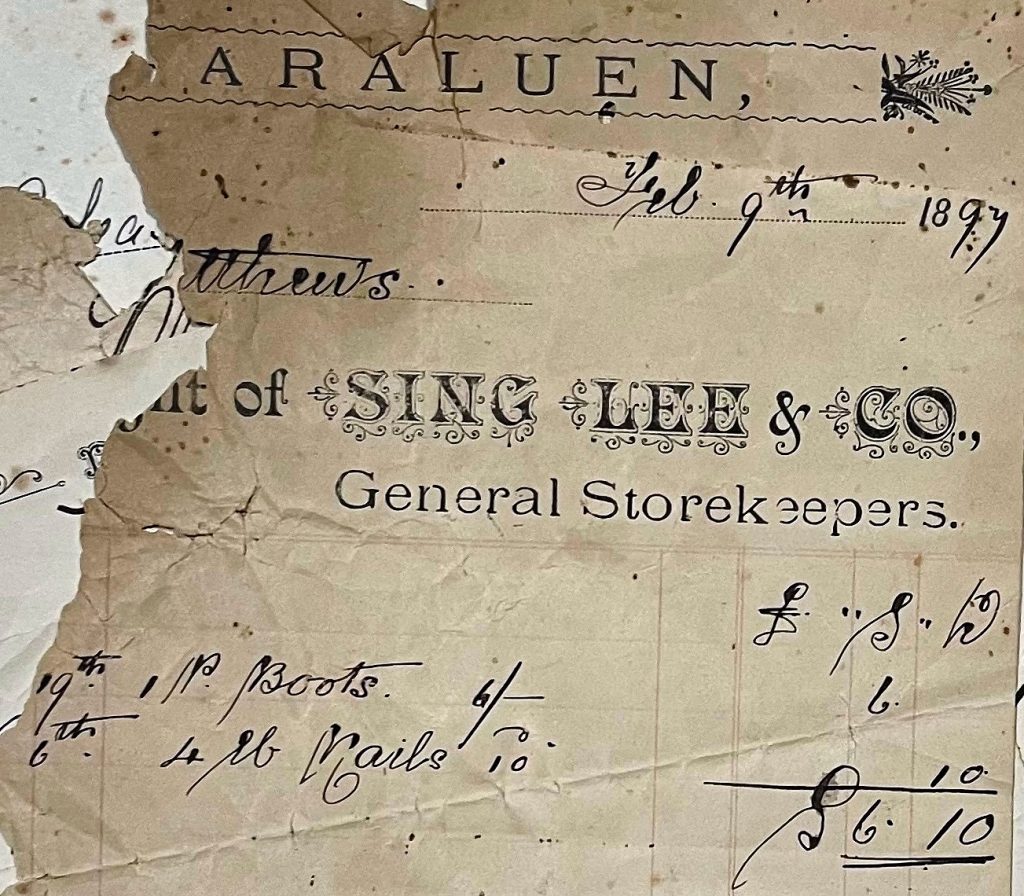Picture – ‘Harvest of Endurance’ scroll, National Museum of Australia. 50 metre scroll painted in 394 days
The Harvest of Endurance was first displayed in December 1988 at the Museum of Chinese Australian History in Melbourne.
In 1992, the National Museum of Australia acquired the scroll for the National Historical Collection.
By the early 1850s1Museum of History New South Wales. https://mhnsw.au/stories/general/chinese-goldfields. Accessed 14 February 2023 news of a gold rush in Australia had reached southern China, sparking an influx in Chinese migration to Australia. It is thought that approximately 7,000 Chinese people came to work at the Araluen goldfields in Southern NSW. The Chinese miners often worked in organised groups of 30 to 100 men under the direction of a leader, which resulted in their gold digging efforts being very successful. Newspapers at that time often ran inflammatory materials.
Chinese miners
Chinese miners arrived in very large numbers in the Braidwood district from 1858 on.2Braidwood and District Historical Society, Braidwood’s Chinese Pioneers. http://www.braidwoodmuseum.org.au/Chinese.html Dr Barry McGowan. 2004. Accessed 17 February 2023 By 1859, the Chinese miners were well established on the major alluvial fields, in particular Araluen, Majors Creek, Bells Creek, Jembaicumbene and Mongarlowe.
In the Braidwood district the Chinese miners were, as elsewhere in Australia, willing immigrants. Although some paid their own way, most came on what is called the credit-ticket system, and were sponsored by merchants in Hong Kong and Australia. The Chinese preference of working in large cooperative groups served them well, and much of their success can be attributed to this mode of working.
The Chinese men were not just miners, but business entrepreneurs and market gardeners. Both forms of enterprise constituted profitable and relatively secure activities, for many of their customers were Europeans. Chinese gardens were located on the Jembaicumbene and Araluen goldfields. At Araluen an observer in 1896 commented that the Chinese gardens were the ‘only pleasant colouring in the whole landscape‘.3Barry McGowan. The Golden South. A History of the Araluen, Bells Creek and Majors Creek Goldfields. Capital Fine Print, Canberra. 2000. p 103
On the mining fields, the Chinese miners lived in small mining camps or in larger villages located on the outskirts of the main European villages. The largest Chinese village was at Jembaicumbene with Chinese temples and cemeteries were located on the Araluen, Jembaicumbene and Mongarlowe goldfields.
On the gold fields, Quong Tart became the Government Interpreter for the districts of Braidwood, Araluen and Majors Creek. Serious incidents of racial violence on the Braidwood goldfields were rare. One factor was the degree of economic co-existence and interdependence between the Europeans and Chinese. Thanks to their successful organisation and work habits, Chinese miners were in a position to purchase mining claims from European miners, and were also valued for their role as storekeepers and market gardeners. An absence of violence did not mean that miners or townsfolk always welcomed the Chinese miners, and racial prejudices and ill-feeling still often surfaced; the local press sometimes referring to them in disparaging terms. But the Chinese miners were very well served by their mode of organisation to resist most incursions by Europeans and were well placed to force issues with the European miners, rather than pursue disputes through the courts.
In Araluen
On 10 September 1859, the Empire newspaper4Empire (Sydney, NSW : 1850-1875), Saturday 10 September 1859, p 4 reported ‘that the Chinese who arrived on the Bells Paddock field are doing well, as they generally do wherever they settle down. This may be accounted for by their perseverance, and by their washing such tailings and other dirt as Europeans would pass by.’

Ex–Senior Superintendent Brennan who was the gold receiver and escort conductor at Araluen for seven years, recollects in 1909, that in 1859 the miners numbered more than a thousand, including six hundred Chinese5Freeman’s Journal (Sydney, NSW : 1850-1932), Thursday 9 September 1909, p 41 who had an extensive camp, stores, and a joss-house. The mining laws in those days prohibited the Chinese6Freeman’s Journal (Sydney, NSW : 1850 – 1932), Thursday 30 September 1909, page 57 from working within the limits of a proclaimed goldfield, but a greater part of the mining area worked at Araluen was private property, hence the law did not affect them. The Chinese had their large camps in the valley, the principal being near Crown Flat, where about 1,000 resided. They had shops, stores, a drug store, a butcher’s shop, and a joss-house. They profitably worked a large engine claim. Most came from the Californian goldfields, and were experienced miners, who worked their claims more systematically than the Europeans did. They taught many Europeans fluming, tunneling, puddling, sluicing, and cradling on improved principles. Several claims on private land were worked co-jointly by Europeans and Chinese, who shared alike; and in one instance the shareholders placed a Chinese miner in full charge of the working operations, because he understood mining thoroughly.
By 1870
In 1870 it was reported that ‘the Chinese party7Sydney Mail (NSW : 1860-1871), Saturday 30 July 1870, p 9 are doing pretty well just below the old Crown Flat Store; they are driving right under the present road, they have been at work at that point for some time, and seem well satisfied with what they got.‘
| The 1871 Census8Historical and Colonial Census Data Archive (HCCDA) Dataverse (ANU) https://dataverse.ada.edu.au/dataset.xhtml?persistentId=doi:10.26193/MP6WRS . Accessed 14 February 2023 details the religions | Araluen East | Araluen East | Araluen West | Araluen West |
| Male 1871 | Female 1871 | Male 1871 | Female 1871 | |
| Pagans* | 80 | 3 | 37 | 3 |
